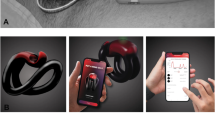Abstract
Aim: An improved understanding of the relationship between radial and axial rigdity values would enable better appreciation of the clinical usefulness of RigiScan™, the most widely utilized determination of erectile rigidity testing. Previous studies have shown that axial rigidity (measured by buckling forces) correlated well with radial rigidity (measured by RigiScan™) for radial rigidity values below 60%. For radial rigidity exceeding 60%, there was poor correlation. Heretofore, there has been no physiologic explanation of this phenomenon.
Methods: During dynamic pharmacocavernosometry in 36 impotent patients, we investigated the relationship between axial buckling forces and RigiScan™ radial rigidity and, for the first time, how they both vary with pressure, (which we varied over over a wide functional range). In addition, we recorded multiple penile length and diameter values enabling us to relate, also for the first time, axial and radial rigidity to individual mechanical erectile tissue and penile geometric properties.
Results: Marked differences were found in the manner RigiScan™ radial rigidity units and axial buckling force magnitudes increased with increases in intracavernosal pressure values in each individual. The former asymptotically approached a maximum finite value while the latter increased continuously towards infinity. Based on data in this study, RigiScan™ radial rigidity values greater than 55% may be considered a necessary criteria for vaginal intromission capability in all partners but it is not a sufficient one.
Conclusions: Axial and radial rigidity share a common dependency upon intracavernosal pressure, however, they are also dependent upon other unique physical determinants. For axial rigidity, additional dependent variables include cavernosal erectile tissue properties and penile geometry, while for radial rigidity, this may include tunical surface wall tension properties. Clinical devices which assess functional penile rigidity should utilize axial and not radial rigidity testing.
Similar content being viewed by others
Author information
Authors and Affiliations
Rights and permissions
About this article
Cite this article
Udelson, D., Park, K., Sadeghi-Najed, H. et al. Axial penile buckling forces vs Rigiscan™ radial rigidity as a function of intracavernosal pressure: why Rigiscan does not predict functional erections in individual patients. Int J Impot Res 11, 327–337 (1999). https://doi.org/10.1038/sj.ijir.3900443
Received:
Accepted:
Published:
Issue Date:
DOI: https://doi.org/10.1038/sj.ijir.3900443
- Springer Nature Limited
Keywords
This article is cited by
-
Nocturnal penile tumescence devices: past, present and future
International Journal of Impotence Research (2023)
-
Applications of artificial intelligence in the diagnosis and prediction of erectile dysfunction: a narrative review
International Journal of Impotence Research (2023)
-
New methods for the monitoring of nocturnal erections
International Journal of Impotence Research (2022)
-
Advantages and limitations of sleep-related erection and rigidity monitoring: a review
International Journal of Impotence Research (2018)
-
The engineering analysis of bioheat equation and penile hemodynamic relationships in the diagnosis of erectile dysfunction: part I—theoretical study and mathematical modeling
International Journal of Impotence Research (2008)




